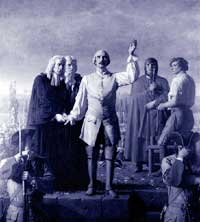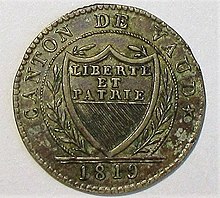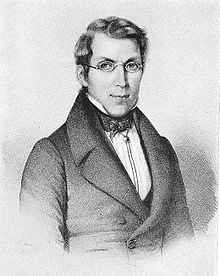History of the Canton of Vaud
The history of the canton of Vaud describes the canton of Vaud , which has only existed in its current form since 1803.
Helvetic and Roman times
In prehistoric times the first settlements were formed on the shores of Lake Geneva, and in Celtic times the Helvetii settled on the soil of what is now the canton of Vaud . Under Julius Caesar Helvetia became 58 BC. And since then the area has been ruled by the Romans . Aventicum ( Avenches ), Viviscus ( Vevey ), Noviodunum ( Nyon ), Eburodunum ( Yverdon ) and Lausonium / Lausonna ( Lausanne ) as well as other localities in Vaud were Roman cities.
Today Roman traces can be found mainly in Avenches and its surroundings. Avenches had become a colony under Emperor Vespasian .
middle Ages
Avenches was destroyed by the Alemanni as early as 260 , and the Burgundians occupied the country around 470 , with whom it came under Frankish rule in 534 . Under this, the Vaud with Neuchâtel and part of today's canton Freiburg formed the large county of Waldgau (pagus Waldensis) , which has been mentioned in a document since 766 , from which the French name Vaud and the German name Vaud come from. In 888, under the Carolingians, Vaud became part of the New Burgundian Empire, with which it fell to the Zähringers and thus to the Holy Roman Empire in 1032 . After the Zähringer died out, Vaud came to Savoy in 1218 ; only Lausanne, as an episcopal city, was able to maintain its imperial immediacy . As a result of the alliance between Duchess Jolanthe and Charles the Bold , Vaud became the main theater of the Burgundian Wars in 1475 and 1476 . Since Bern and Freiburg retained the then conquered cities of Murten , Grandson , Orbe and Echallens as common lords , the unification of the country with the Swiss Confederation was initiated.
Reformation and Bernese rule
Under Bern's protection, Guillaume Farel and Pierre Viret introduced the Reformation in Vaud from 1526 . When the Duke of Savoy threatened Geneva , which was allied with Bern , the troops of the city of Bern under the chief field captain Hans Franz Nägeli, together with Friborg , completely conquered the Savoy region in Vaud. Even Lausanne, although an imperial city and allied with Bern since 1525, had to pay homage to the occupying power. In the Lausanne Treaty of October 30, 1564, Duke Emmanuel Philibert of Savoy formally ceded Vaud to Bern, which, however, had to return other areas conquered in 1536 to Savoy.
During the Bernese rule Vaud experienced a relatively peaceful time; An exception is a rebellion under Major Davel , who was executed by the Bernese on April 24, 1723 as a rebel and is considered a popular hero in Vaud .
The vaudoise revolution
In January 1798, when the old Confederation collapsed and the French troops came closer, there was a small revolution in Vaud and the Bernese governors , who represented the " LL. EE. De Berne " (Leurs Excellences de Berne), returned to Sent home and proclaimed the République lémanique . The Révolution vaudoise is still celebrated today on January 24th, mostly with Bernerplatte and sauerkraut .
Founding of a canton
With the final French invasion in April 1798, the newly created Canton du Léman was formed in Helvetic from Vaud and Geneva . Despite the revolt of the Bourla-Papey against land taxes in the spring of 1802, the canton of Léman was the last power base of the government during the collapse of the Helvetic Republic in the autumn of the same year. In 1803, through the mediation act of Napoléon Bonaparte , Vaud became independent together with the cantons of Thurgau , St. Gallen , Aargau , Graubünden and Ticino . With this she also joins the Federation. Until the April 17, 1825 entered into between the cantons of Aargau, Basel, Bern, Friborg, Solothurn and Vaud coinage coined Vaud own coins (100 cents = 10 chunk = 1 franc).
Constitution and Sonderbund War

The new canton was able to maintain its independence in the restoration years after 1814, although representative democracy was approximated to an oligarchy through complicated electoral forms .
On December 17, 1830, the people who had gathered in Lausanne compelled the Grand Council to convene a constitutional council. It was the universal suffrage introduced and immediate elections and approved on 25 May 1831 by the people. The doctrinal position of the authorities on the Jesuit question provoked a new uprising on February 14th and 15th, 1845, which forced the State Council and the Grand Council to abdicate and modified the constitution in a democratic sense by shortening the terms of office, introducing the optional referendum, etc. During the Sonderbund War of 1847, Vaud was on the side of the opponents of the Catholic movement.
The foundation of the Église évangélique libre du Canton de Vaud
Before the cantonal referendum on the new constitution, 40 pastors refused a state council order from August 1845. This provided that they would have to read a proclamation from the new state government from the pulpits. Some pastors left the reading of the text to the teachers. The 40 pastors were punished with suspension. 184 clergymen then submitted their resignation and founded - following the example of the separation of the Free Church of Scotland from the state church in Scotland in 1843 - under the leadership of Alexandre Vinet and Charles Monnard, a free church separate from the state ( Église libre évangélique ). The resigning pastors made up over half of the Vaudois ministry and many of them were at least politically liberal. The majority of the community members remained in the state church. Many of these were bothered by the methodistic character of the pietistic piety culture. The Vaudois Church was seen by many as a home, also because of its role during the Bern occupation.
The Free Church was harassed by the radical Council of State led by Henri Druey . The state government wanted a democratic, egalitarian national church tied to the state. The new constitution did not provide for freedom for free churches, which was felt to be alien in the strongly rural and pietistic Vaudois population. In addition, the government fired teachers and professors who attended a free church service. In Lausanne, the Council of State ordered the break-up of the Free Church in 10 to 15 small assemblies under threat of physical violence.
The Free Church was definitively constituted in 1847 and gathered many of the previous active churchgoers of the State Church in around 50 free congregations and 3400 members. Its emergence was encouraged by the events that led to the formation of the Free Church of Scotland in 1843 . As a logical consequence, part of the professors and the majority of theology students also left the state academy. On November 10, 1846, delegates from 33 parishes in Lausanne founded their own synod. As a result, on November 18, 1847, theological training center was established.
On November 24, 1847, the State Council dictatorially forbade attending religious meetings outside the State Church under threat of violence and criminal prosecution. The British Evangelical Alliance took action on behalf of the persecuted Christians in Vaud. Donations came from Scotland and letters were sent to the State Council from the United States. On March 28, 1848, the State Council tightened the decree again. In the cantonal hospital, even the Christian tracts were removed from the library, as Lindemann reports. Only a third of the members of the Grand Council (Parliament) were against the religious policy of the State Council in May 1848. On June 7, 1849, the Grand Council banned all religious gatherings outside the state church, with the exception of family gatherings. In 1851 religious freedom was effectively restored. In 1859 the ban on assembly was lifted.
In 1861, conservatives and ultra-radicals united on a political level to overthrow the government of Druey's like-minded people by means of a constitutional revision and to put an end to coercion against the Free Church, without the new Basic Law, adopted on December 15 of that year, making the constitution essential would have changed. From 1863 the state church was no longer subordinate to the political authorities. Parish councils and a synod were established.
In 1966 the EEL was reunited with the regional church.
From 1874 until today
In June 1874 the Swiss Federal Assembly designated Lausanne as the seat of the Federal Court, which had become permanent through the new constitution .
The current constitution of Vaud is dated April 14, 2003 and replaces that of 1885. With it, the canton of Vaud became the first Swiss canton to introduce a permanent regional council with limited authority to issue guidelines .
literature
- Lucienne Hubler: Histoire du Pays de Vaud . Loisirs et Pédagogie, Lausanne 1991, ISBN 2-606-00526-0 .
Individual evidence
- ^ Fabienne Abetel-Béguelin: Treaty of Lausanne. In: Historical Lexicon of Switzerland .
- ↑ a b c d e f Gerhard Lindemann : For piety in freedom. The history of the Evangelical Alliance in the Age of Liberalism (1846-1879). Lit, Berlin 2011, ISBN 978-3-8258-8920-3 , pp. 141-151.






